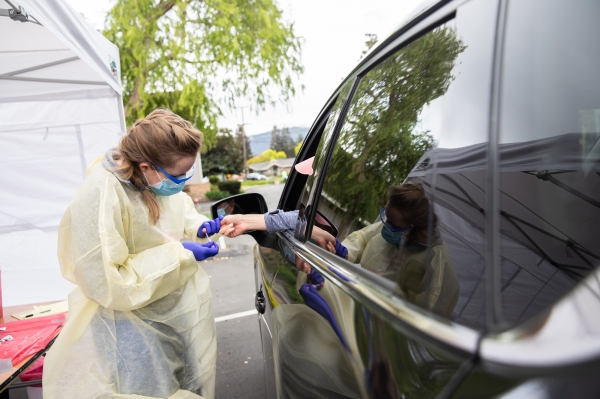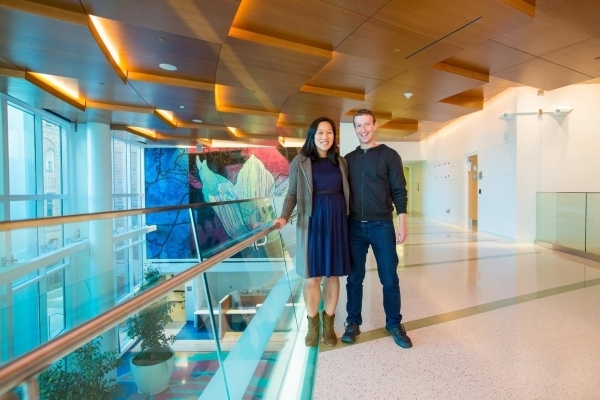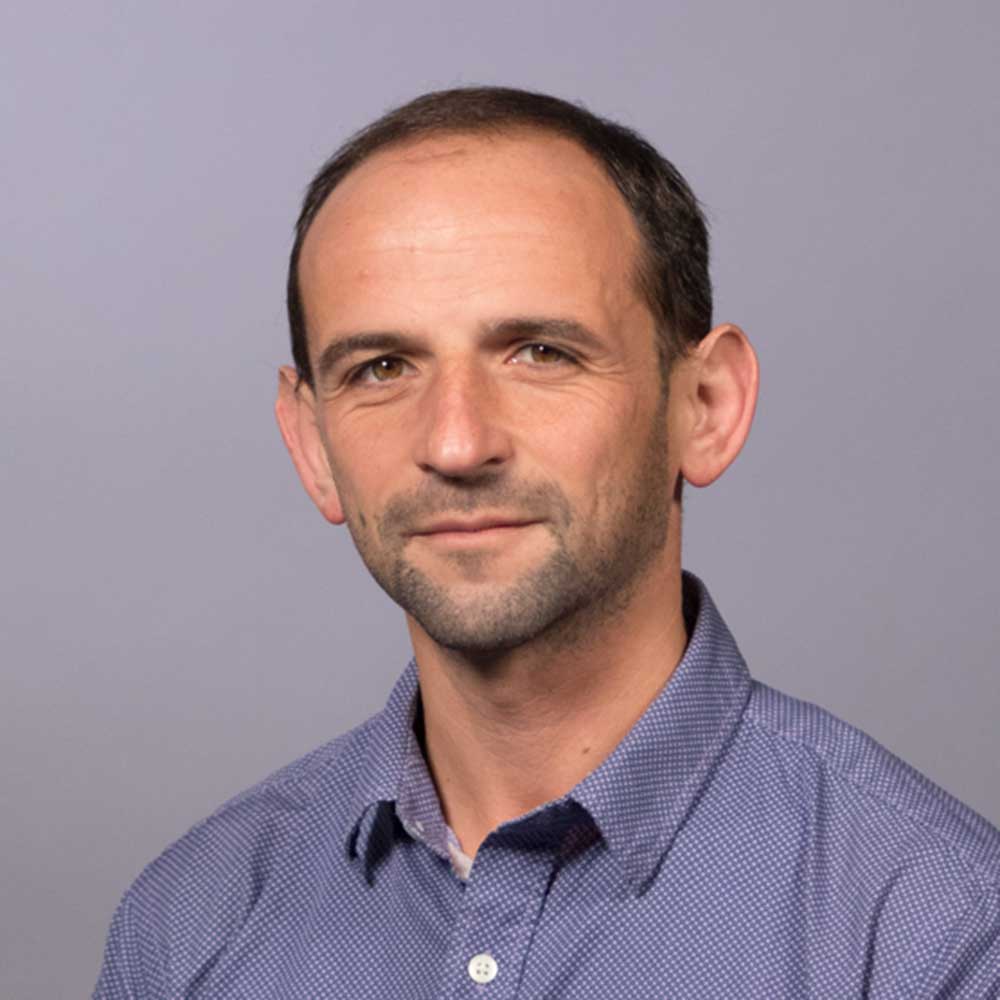Seeking to answer critical questions about the spread of COVID-19 in the Bay Area, Stanford University and the University of California, San Francisco are preparing to launch two large studies that would track and test thousands of residents and health care workers over the next nine months.
The studies, which are supported by a $13.6 million grant from the Chan Zuckerberg Initiative, comprise one of the Bay Area's most ambitious efforts yet to gauge the prevalence of the virus and determine whether those who had contracted it are immune from reinfection.
In the first of two studies, which the Chan Zuckerberg Initiative announced Wednesday, a consortium led by Stanford and UCSF researchers will recruit a representative sample of about 4,000 residents from across the Bay Area, each of whom had tested negative for COVID-19 and had followed the existing shelter-at-home guidelines.
The study will be led by Dr. Yvonne Maldonado, Stanford professor of pediatrics and of health research and policy at Stanford Medicine, and George Rutherford, professor of epidemiology, preventive medicine and pediatrics at UCSF. In the Wednesday announcement, Maldonado said the studies would enable researchers to learn "whether and how the virus spreads in the coming months and whether infection confers lasting immunity."
"This knowledge will be critical in coming months as we explore new treatment and prevention options for the novel coronavirus," Maldonado said.
Rutherford said the data produced by the study will be "not only instrumental in deciding when and how to relax our stringent public health interventions but also to monitor the population for new transmissions going forward."
"These data will be crucial to informing rational public health practice," Rutherford said in a statement.
Participants in this study will be tested once a month between May and December using polymerase chain reaction (PCR) tests, which typically rely on nasal swabs and which check for the virus' genetic material, and serological tests, which check blood samples for antibodies to COVID-19.
While PCR tests check for the presence of the virus at the time of testing, serological tests can demonstrate whether someone has had it in the past and has recovered. The new research effort is part of a growing number of prevalence studies undertaken by researchers across the world as nations consider strategies for reopening their economies.
Stanford researchers have already completed one prevalence study, though that study was based solely on serological tests of about 3,300 blood samples. The results of that study, which is now undergoing peer review and which has not been formally published, have stirred debate among researchers about the accuracy of test kits and the methods used to recruit participants.
In the new population study, viral genomes of all positive samples will be sequenced by researchers at the Chan Zuckerberg Biohub, a research center set up as a collaboration between Stanford, the University of California, Berkeley and UCSF. According to the announcement from the Chan Zuckerberg Initiative, the sequencing work will "identify local transmission chains or introductions of virus from outside the Bay Area, in addition to informing whether co-infections with other pathogens play a significant role."
"Altogether, the combined data will provide critical insights into the changing rates of COVID-19 infections as the Bay Area begins to return to work," the announcement states.
The second study will target about 3,500 health care workers, all of whom had previously tested negative for COVID-19. Participants will be tested weekly for 12 weeks using both PCR and serological testing to determine the rate at which workers acquire the disease. Those who test positive through serological testing — indicating that they had contracted the disease in the past even if they don't currently have it — will be followed in parallel through December.
Researchers expect the study to answer critical questions about whether antibodies actually confer immunity to the virus and whether reinfection is likely, according to the announcement.
Dr. Priscilla Chan, co-founder and co-CEO of the Chan Zuckerberg Initiative, said in a statement that "to reopen society and keep health care workers safe, we need to first understand the epidemiology of this disease.
"How much of our population is currently infected with COVID-19? How prevalent is asymptomatic spread? And how can we use this information to better understand who may still be at risk in the future? There is no shortcut to answering these questions – it will require testing, retesting and the sort of rigorous public health surveying this program is focused on in California," Chan said.
Find comprehensive coverage on the Midpeninsula's response to the new coronavirus by Palo Alto Online, the Mountain View Voice and the Almanac here.




Comments
Adobe-Meadow
on Apr 29, 2020 at 11:14 am
on Apr 29, 2020 at 11:14 am
[Post removed; please provide links that support your assertions of fact.]
College Terrace
on Apr 29, 2020 at 11:17 am
on Apr 29, 2020 at 11:17 am
How will they randomly recruit residents? The only random approach would be through mailings, not social media, that would disproportionately target younger and likely healthier residents.
Leland Manor/Garland Drive
on Apr 29, 2020 at 11:20 am
on Apr 29, 2020 at 11:20 am
One would hope that they have learned some lessons from the last butchered Stanford study where the recruitment was so badly handled that the results of that study seem worthless.
Los Altos Hills
on Apr 29, 2020 at 11:38 am
on Apr 29, 2020 at 11:38 am
Replying to Scarlet Letter: because there have been so many divergent ways of handling this pandemic, we should be able to learn a lot about what works/what doesn’t after the dust settles. Sweden will be an excellent such example.
I would like to hear a discussion among various health ministers comparing their approaches and results.
Evergreen Park
on Apr 29, 2020 at 11:43 am
on Apr 29, 2020 at 11:43 am
Due to violations of our Terms of Use, comments from this poster are only visible to registered users who are logged in. Use the links at the top of the page to Register or Login.
Another Palo Alto neighborhood
on Apr 29, 2020 at 2:06 pm
on Apr 29, 2020 at 2:06 pm
Posted by Tecsi, a resident of Los Altos Hills
>> because there have been so many divergent ways of handling this pandemic, we should be able to learn a lot about what works/what doesn’t after the dust settles. Sweden will be an excellent such example.
From my reading of the statistics, it looks like Sweden has roughly 25-30% higher per-capita death rate than the US. I haven't seen much about Swedish details in the media, though. What fraction of people have antibodies, for example? Where did the victims die? Sweden seems to have a low number of hospital beds per capita, even lower than the US, UK, and Canada. Did older people in convalescent hospitals die there? Is that considered acceptable in Sweden? I know I can't post with a lot of links, so, here is one to an NYTimes article regarding finding out what the true excess death rate is: Web Link The reason that this is important is that quite a few COVID-19 deaths were missed because people who died were not always tested, especially if it appeared that they had a heart attack or stroke. But, as is now widely known, "silent hypoxia" is common among COVID-19 sufferers: Web Link
In any case, given Sweden's higher-than-US COVID-19 death rate, I would like to know a lot more about it before declaring Sweden's policy a "success".
Another thing I would really like to understand is why New York City has had such an extremely high exposure rate. Gov. Cuomo suggested that 25% of NYC residents have blood antibodies; again, I don't know the details, but, this is a very high number compared to many locations. I wonder why NYC appears to have been so susceptible. And, how does that compare with other hotspots in Italy, Spain, a few US cities like New Orleans. Is there a common thread? A lot of people seem to make assumptions about it, but, I haven't seen any confirmation of various hypotheses.
Charleston Meadows
on Apr 29, 2020 at 2:13 pm
on Apr 29, 2020 at 2:13 pm
Thanks Palo Alto on line. Very good infor
Another Palo Alto neighborhood
on Apr 29, 2020 at 3:54 pm
on Apr 29, 2020 at 3:54 pm
Suddenly everyone is talking about Sweden. Please read this article before answering any of my questions above about Sweden:
Web Link
Old Palo Alto
on Apr 29, 2020 at 4:10 pm
on Apr 29, 2020 at 4:10 pm
I sincerely hope they devise a truly random way to select the participants. The last study was completely undermined by the skewed manner it was set up from the start.
University South
on Apr 29, 2020 at 7:00 pm
on Apr 29, 2020 at 7:00 pm
"Sweden has nearly 10 times the number of COVID deaths than its Nordic neighbors"
Killing these far-right lies is a constant battle. Fortunately, we can Google the truth as represented above.
At least the bots don't come back and try and defend the indefensible.
See ya!